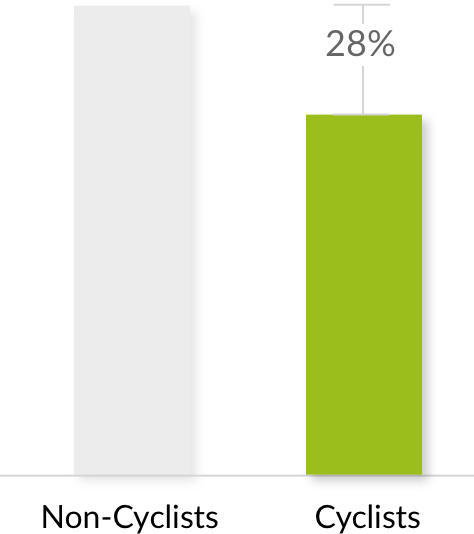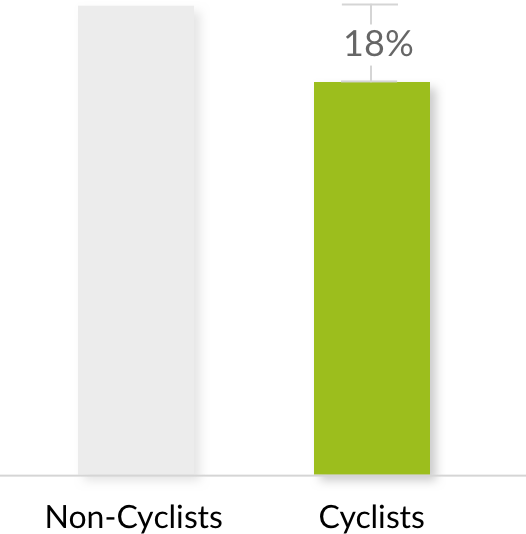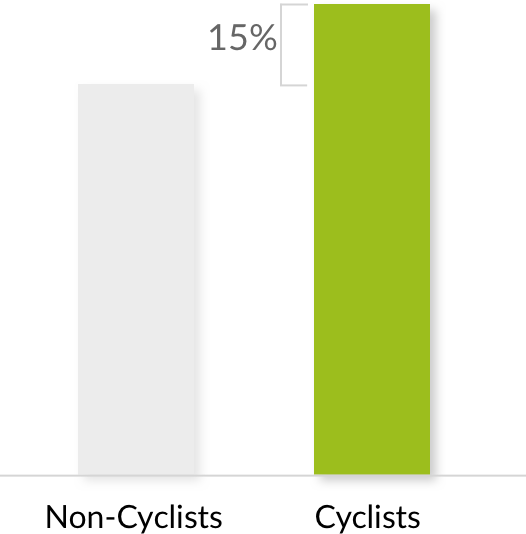
 Cyclists & All-Cause Mortality
Cyclists & All-Cause Mortality
Cyclists who ride for 3 hours a week or more have a 28% lower risk of all-cause mortality than non-cyclists, according to a 2000 study in Archives of Internal Medicine.
In this study of over 30,000 participants, researchers evaluated the relationship between various exertion-levels during cycling and all-cause mortality. Overall, the study concluded that the risks from cycling were reduced equally across all age and gender groups.
Andersen et al. Arch Intern Med. 2000

Decreased Risk of Mortality in Cyclists
 Cyclists & Cancer
Cyclists & Cancer
Cyclists who commute to work at least 30 miles a week have a 45% reduction in all cancer incidence as compared to non-cyclists, according to a 2017 study in the BMJ.
This UK based prospective population based study investigated the association between active commuting and incident cardiovascular disease (CVD), cancer, and all cause mortality. The study included 263 450 participants (106 674 (52%) women; mean age 52.6) from 22 sites across the UK. The exposure variable was the mode of transport used (walking, cycling, mixed mode v non-active (car or public transport)) to commute to and from work on a typical day. The study found that commuting by cycling was associated with a lower risk of all cause mortality and adverse CVD and cancer outcomes, in a dose dependent manner and independent of a range of confounding factors.
Celis-Morales et al. BMJ (2017)

Cyclists & Cancer
Cyclists who commute to work at least 30 miles a week have a 45% reduction in all cancer incidence as compared to non-cyclists, according to a 2017 study in the BMJ.
This UK based prospective population based study investigated the association between active commuting and incident cardiovascular disease (CVD), cancer, and all cause mortality. The study included 263 450 participants (106 674 (52%) women; mean age 52.6) from 22 sites across the UK. The exposure variable was the mode of transport used (walking, cycling, mixed mode v non-active (car or public transport)) to commute to and from work on a typical day. The study found that commuting by cycling was associated with a lower risk of all cause mortality and adverse CVD and cancer outcomes, in a dose dependent manner and independent of a range of confounding factors.
Celis-Morales et al. BMJ (2017)
 Cyclists & Heart Disease
Cyclists & Heart Disease
Cyclists have a 18% lower incidence of cardiovascular disease as compared to non-cyclists, according to a 2011 study in the European Journal of Cardiovascular Prevention.
This study of over 23,000 men and women analyzed the effect of different types of physical activities in relation to cardiovascular disease incidence. Participants that did another sport in addition to cycling had an even greater risk reduction of 36%.
Hoevenaar-Blom MP et al. Eur J Cardiovasc Prev Rehabil. 2011 Feb;18(1):41-7. doi: 10.1097/HJR.0b013e32833bfc87.

Cyclists & Heart Disease
 Cyclists & Life Expectancy
Cyclists & Life Expectancy
Male cyclists live 2.9 - 5.3 years (varying by intensity) longer as compared to non-cycling males. Female cyclists live 2.2 - 3.9 years (varying by intensity) longer than non-cycling females, according to a 2012 study in the European Journal of Preventive Cardiology.
Recommended exercise amounts have historically remained around 30 minutes per day of moderate activity (brisk walking) if possible. This study aimed at examining the impact of intensity and duration of cycling on mortality. The study concluded that relative intensity, and not duration as previously thought, was more important when related to mortality.
Schnohr et al. Eur J of Preventive Cardiology. 2012; Volume 19. doi:10.1177/1741826710393196

Cyclists & Life Expectancy
Male cyclists live 2.9 - 5.3 years (varying by intensity) longer as compared to non-cycling males. Female cyclists live 2.2 - 3.9 years (varying by intensity) longer than non-cycling females, according to a 2012 study in the European Journal of Preventive Cardiology.
Recommended exercise amounts have historically remained around 30 minutes per day of moderate activity (brisk walking) if possible. This study aimed at examining the impact of intensity and duration of cycling on mortality. The study concluded that relative intensity, and not duration as previously thought, was more important when related to mortality.
Schnohr et al. Eur J of Preventive Cardiology. 2012; Volume 19. doi:10.1177/1741826710393196
 Cyclists & HDL Cholesterol
Cyclists & HDL Cholesterol
Cyclists have a 15% increase in HDL-cholesterol as compared to non-cyclists, according to a 2010 study in the Journal for the Norwegian Medical Association.
The study looked at the intervention study on health-related physiological effect of commuter cycling. Increase in HDL-cholesterol was one of the health benefits they found.
L I Tjelta et al. Journal for the Norwegian Medical Association. 2010. Volume 12; doi: 10.4045/tidsskr.09.0787

Cyclists & HDL Cholesterol


We are a licensed life insurance agent* in all 50 states.
View our licenses
We negotiated lower rates on life insurance using science and data.
View our research
By cyclists for cyclists. Our team is comprised of health conscious people who overcame their own health challenges with healthy habits, exercise, and nutrition.
Meet our team
















